Effects of the γ″-Ni3Nb Phase on Mechanical Properties of Inconel 718 Superalloys with Different Heat Treatments
Abstract
1. Introduction
2. Experimental Procedures
2.1. Materials Preparation
2.2. Methodology of Metallographic Investigation
2.3. Tensile Experiments
3. Results
3.1. Microstructural Characterization
3.2. Lattice Misfit
3.3. Mechanical Properties
4. Discussions
5. Conclusions
- The relatively coarser γ″ precipitates formed in the grain boundaries were only observed in the superalloy treated with HIP + DA. Moreover, Inconel 718 superalloys with heat treatments exhibited many fine γ″ precipitates of ~26.49 ± 1.82 nm in mean size.
- The yield strengths of the HIP + DA Inconel 718 superalloy at room temperature and at 650 °C both possessed the maximum values which were 993 ± 5.7 and 811 ± 12.6 MPa, respectively, compared to the SHT and HIP + STA samples. In addition, the ultimate tensile strength and elongation values of the HIP + DA Inconel 718 superalloy were better than those of the alloys treated with SHT and HIP + STA.
- The dominant strengthening phase was the γ″ precipitate in the Inconel 718 superalloy, because the lattice misfits (ε) of γ/γ″ in all conditions possessed higher values than that of γ/γ′.
- The strengthening mechanisms of the Inconel 718 superalloy after SHT and HIP + STA treatments can be explained by the coherency strain strengthening mechanism due to the formation of fine γ″ precipitates. However, a combination of coherency strain strengthening and a dislocation-cut ordered particle strengthening mechanism is considered to be the reason for the strengthening of the Inconel 718 superalloy treated with HIP + DA.
Author Contributions
Funding
Conflicts of Interest
References
- Baccinoa, R.; Moreta, F.; Pellerinb, F.; Guichardc, D.; Raisso, G. High performance and high complexity net shape parts for gas turbines: The ISOPREC powder metallurgy process. Mater. Des. 2000, 21, 345–350. [Google Scholar] [CrossRef]
- Özgün, Ö.; Gülsoy, H.Ö.; Yılmaz, R.; Fındık, F. Microstructural and mechanical characterization of injection molded 718 superalloy powders. J. Alloys Compd. 2013, 576, 140–153. [Google Scholar] [CrossRef]
- Rao, G.A.; Kumar, M.; Srinivas, M.; Sarma, D.S. Effect of standard heat treatment on the microstructure and mechanical properties of hot isostatically pressed superalloy inconel 718. Mater. Sci. Eng. A 2003, 355, 114–125. [Google Scholar] [CrossRef]
- Liu, Y.; Wu, Y.; Yu, J.; Ju, J.; Zhang, Z.; Kang, M.; Wang, J.; Sun, B.; Ning, Y. Temperature-dependent deformation mechanisms and microstructural degradation of a polycrystalline nickel-based superalloy. J. Alloys Compd. 2019, 775, 181–192. [Google Scholar] [CrossRef]
- He, Z.; Zhang, Y.; Qiu, W.; Shi, H.J.; Gu, J. Temperature effect on the low cycle fatigue behavior of a directionally solidified nickel-base superalloy. Mater. Sci. Eng. A 2016, 676, 246–252. [Google Scholar] [CrossRef]
- Anderson, M.; Thielin, A.L.; Bridier, F.; Bocher, P.; Savoie, J. δ Phase precipitation in Inconel 718 and associated mechanical properties. Mater. Sci. Eng. A 2017, 679, 48–55. [Google Scholar] [CrossRef]
- Chang, L.; Sun, W.; Cui, Y.; Zhang, F.; Yang, R. Effect of heat treatment on microstructure and mechanical properties of the hot-isostatic-pressed Inconel 718 powder compact. J. Alloys Compd. 2014, 590, 227–232. [Google Scholar] [CrossRef]
- Chamanfar, A.; Sarrat, L.; Jahazi, M.; Asadi, M.; Weck, A.; Koul, A.K. Microstructural characteristics of forged and heat treated Inconel-718 disks. Mater. Des. 2013, 52, 791–800. [Google Scholar] [CrossRef]
- Pollock, T.M.; Tin, S. Nickel-Based Superalloys for Advanced Turbine Engines: Chemistry, Microstructure and Properties. J. Propul. Power 2006, 22, 361–374. [Google Scholar] [CrossRef]
- Kang, M.; Gao, H.; Wang, J.; Ling, L.; Sun, B. Prediction of Microporosity in Complex Thin-Wall Castings with the Dimensionless Niyama Criterion. Materials 2013, 6, 1789–1802. [Google Scholar] [CrossRef]
- Goel, S.; Sittiho, A.; Charit, I.; Klement, U.; Joshi, S. Effect of post-treatments under hot isostatic pressure on microstructural characteristics of EBM-built Alloy 718. Addit. Manuf. 2019, 28, 727–737. [Google Scholar] [CrossRef]
- Chang, S.H.; Lee, S.C.; Tang, T.P.; Ho, H.H. Evaluation of HIP pressure on Inconel 718 superalloy. Int. J. Cast Met. Res. 2006, 19, 181–187. [Google Scholar] [CrossRef]
- Chang, S.H.; Lee, S.C.; Huang, K.T.; Liang, C. Effects of Solid-Solution Treatment on Microstructure and Mechanical Properties of HIP Treated Alloy 718. Appl. Mech. Mater. 2012, 117, 1315–1318. [Google Scholar] [CrossRef]
- Chang, S.H.; Lee, S.C.; Tang, T.P.; Ho, H.H. Effects of temperature of HIP process on characteristics of Inconel 718 superalloy. Cast Met. 2013, 19, 175–180. [Google Scholar] [CrossRef]
- Chang, S.H. In situ TEM observation of γ′, γ″ and δ precipitations on Inconel 718 superalloy through HIP treatment. J. Alloys Compd. 2009, 486, 716–721. [Google Scholar] [CrossRef]
- Rezaie, A.; Vahdat, S.E. Study of Effects of Temperature and Pressure in HIP Process on Mechanical Properties of Nickel-based Superalloys. Mater. Today Proc. 2017, 4, 152–156. [Google Scholar] [CrossRef]
- Qiu, C.L.; Attallah, M.M.; Wu, X.H.; Andrews, P. Influence of hot isostatic pressing temperature on microstructure and tensile properties of a nickel-based superalloy powder. Mater. Sci. Eng. A 2013, 564, 176–185. [Google Scholar] [CrossRef]
- Chang, S.H.; Lee, S.; Tang, T.P.; Ho, H.H. Influences of Soaking Time in Hot Isostatic Pressing on Strength of Inconel 718 Superalloy. Mater. Trans. 2006, 47, 426–432. [Google Scholar] [CrossRef]
- Kim, M.T.; Chang, S.Y.; Won, J.B. Effect of HIP process on the micro-structural evolution of a nickel-based superalloy. Mater. Sci. Eng. A 2006, 441, 126–134. [Google Scholar] [CrossRef]
- Rao, G.A.; Srinivas, M.; Sarma, D.S. Influence of modified processing on structure and properties of hot isostatically pressed superalloy Inconel 718. Mater. Sci. Eng. A 2006, 418, 282–291. [Google Scholar] [CrossRef]
- Popovich, A.A.; Sufiiarov, V.S.; Polozov, I.A.; Borisov, E.V. Microstructure and Mechanical Properties of Inconel 718 Produced by SLM and Subsequent Heat Treatment. Key Eng. Mater. 2015, 651, 665–670. [Google Scholar] [CrossRef]
- Liu, Y.; Wu, Y.; Kang, M.; Wang, M.; Li, M.; Gao, H.; Wang, J.; Sun, B.; Ning, Y. Fracture mechanisms induced by microporosity and precipitates in isothermal fatigue of polycrystalline nickel based superalloy. Mater. Sci. Eng. A 2018, 736, 438–452. [Google Scholar] [CrossRef]
- Monajati, H.; Jahazi, M.; Bahrami, R.; Yue, S. The influence of heat treatment conditions on γ′ characteristics in Udimet® 720. Mater. Sci. Eng. A 2004, 373, 286–293. [Google Scholar] [CrossRef]
- Qiu, C.; Wu, X.; Mei, J.; Andrews, P.; Voice, W. Influence of heat treatment on microstructure and tensile behavior of a hot isostatically pressed nickel-based superalloy. J. Alloys Compd. 2013, 578, 454–464. [Google Scholar] [CrossRef]
- Liu, Y.; Kang, M.; Wu, Y.; Wang, M.; Li, M.; Yu, J.; Gao, H.; Wang, J. Crack formation and microstructure-sensitive propagation in low cycle fatigue of a polycrystalline nickel-based superalloy with different heat treatments. Int. J. Fatigue 2018, 108, 79–89. [Google Scholar] [CrossRef]
- Qin, H.; Bi, Z.; Yu, H.; Feng, G.; Du, J.; Zhang, J. Influence of stress on γ″ precipitation behavior in Inconel 718 during aging. J. Alloys Compd. 2018, 740, 997–1006. [Google Scholar] [CrossRef]
- Popovicha, V.A.; Borisovb, E.V.; Popovichb, A.A.; Sufiiarovb, V.S.H.; Masaylob, D.V.; Alzina, L. Impact of heat treatment on mechanical behaviour of Inconel 718 processed with tailored microstructure by selective laser melting. Mater. Des. 2017, 131, 12–22. [Google Scholar] [CrossRef]
- Sundararaman, M.; Mukhopadhyay, P.; Banerjee, S. Some aspects of the precipitation of metastable intermetallic phases in INCONEL 718. Metall. Trans. A 1992, 23, 2015–2028. [Google Scholar] [CrossRef]
- Pope, C.G. X-ray Diffraction and the Bragg Equation. J. Chem. Educ. 1997, 74, 129–131. [Google Scholar] [CrossRef]
- Nickel Alloy, Corrosion and Heat Resistant, Sheet, Strip, Foil, and Plate 52.5Ni 19Cr 3.0Mo 5.1Cb 0.90Ti 0.50Al 18Fe Consumable Electrode or Vacuum Induction Melted, 1775 °F (968 °C) Solution Heat Treated; AMS5596; SAE International: Warrendale, PA, USA, 1964.
- Nickel Alloy, Corrosion and Heat Resistant, Bars, Forgings, and Rings 52.5Ni 19Cr 3.0Mo 5.1Cb 0.90Ti 0.50Al 18Fe, Consumable Electrode or Vacuum Induction Melted 1775 °F (968 °C) Solution Heat Treated, Precipitation Hardenable; AMS5662G; SAE International: Warrendale, PA, USA, 1993.
- Nembach, E.; Neite, G. Precipitation hardening of superalloys by ordered γ′-particles. Prog. Mater Sci. 1985, 29, 177–319. [Google Scholar] [CrossRef]
- Raynor, D.; Silcock, J.M. Strengthening Mechanisms in γ′ Precipitating Alloys. Met. Sci. J. 1970, 4, 121–130. [Google Scholar] [CrossRef]
- Oblak, J.M.; Paulonis, D.F.; Duvall, D.S. Coherency strengthening in Ni base alloys hardened by DO 22 γ′ precipitates. Metall. Trans. 1974, 5, 143–153. [Google Scholar]
- Chaturvedi, M.C.; Han, Y.F. Strengthening mechanisms in Inconel 718. Metal Sci. 1983, 17, 145–149. [Google Scholar] [CrossRef]
- Gleiter, H.; Hornbogen, E. Theorie der Wechselwirkung von Versetzungen mit kohärenten geordneten Zonen (I). Phys. Status Solidi 2010, 12, 235–250. [Google Scholar] [CrossRef]
- Gleiter, H.; Hornbogen, E. Precipitation hardening by coherent particles. Mater. Sci. Eng. 1968, 2, 285–302. [Google Scholar] [CrossRef]
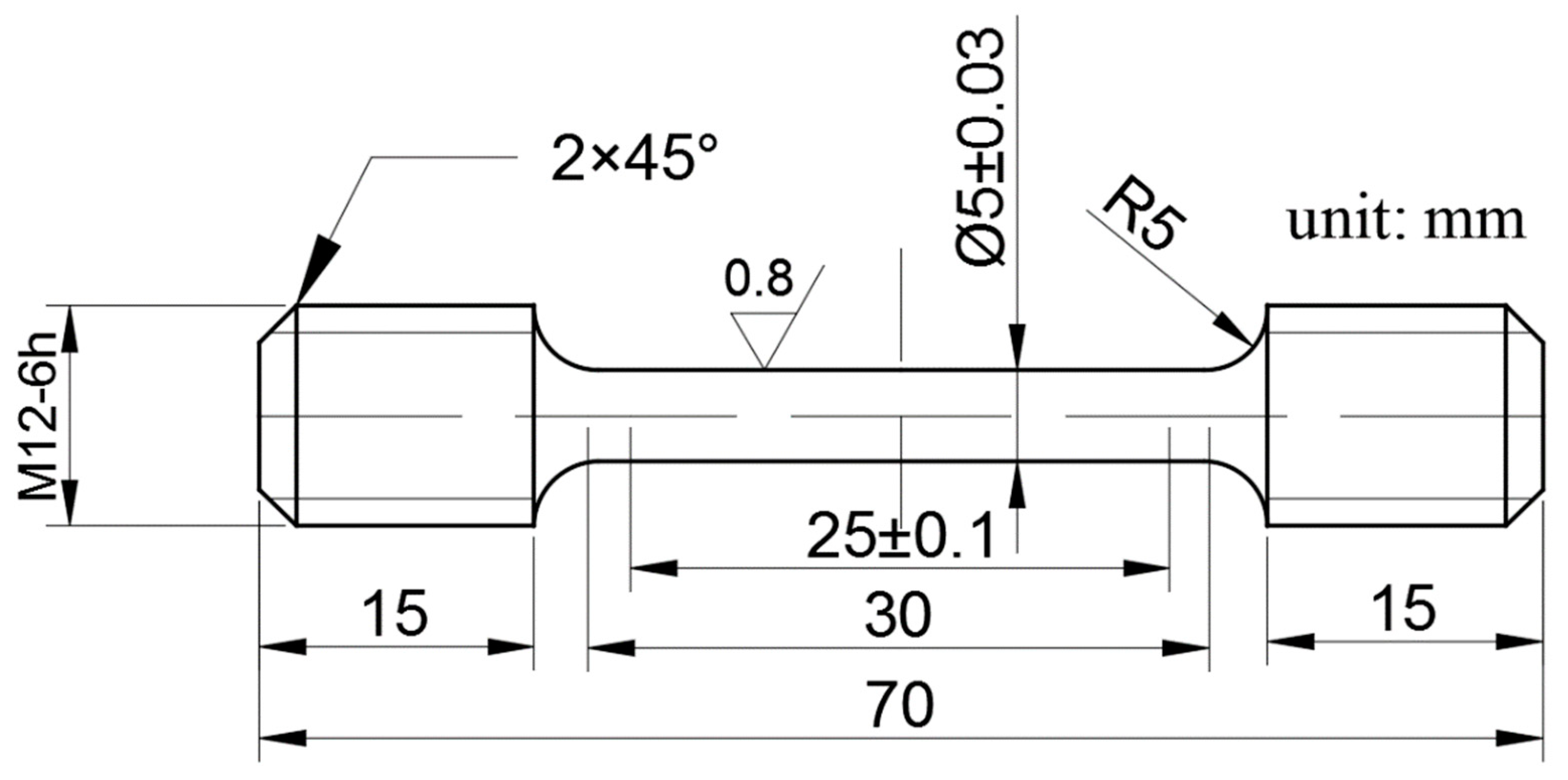
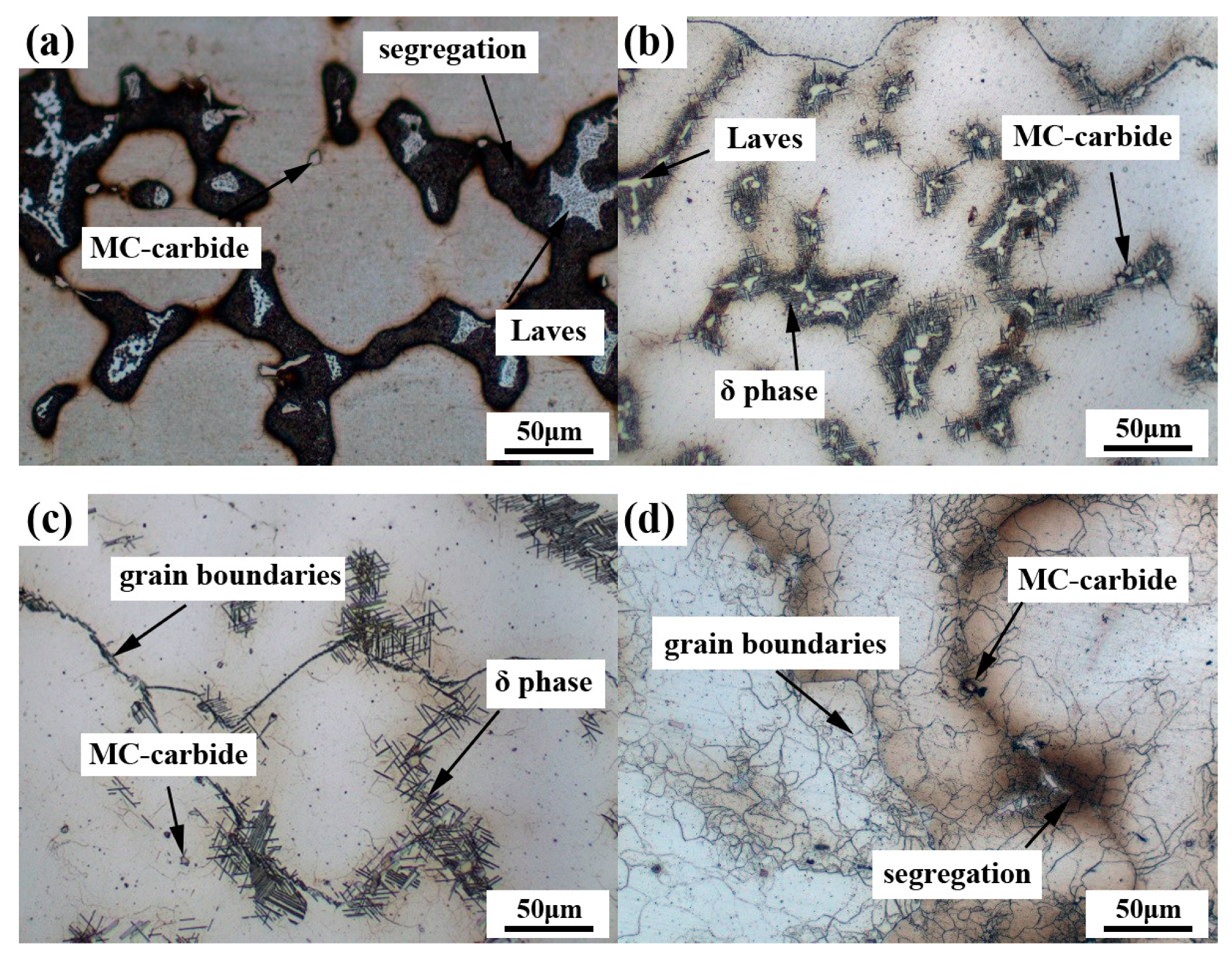
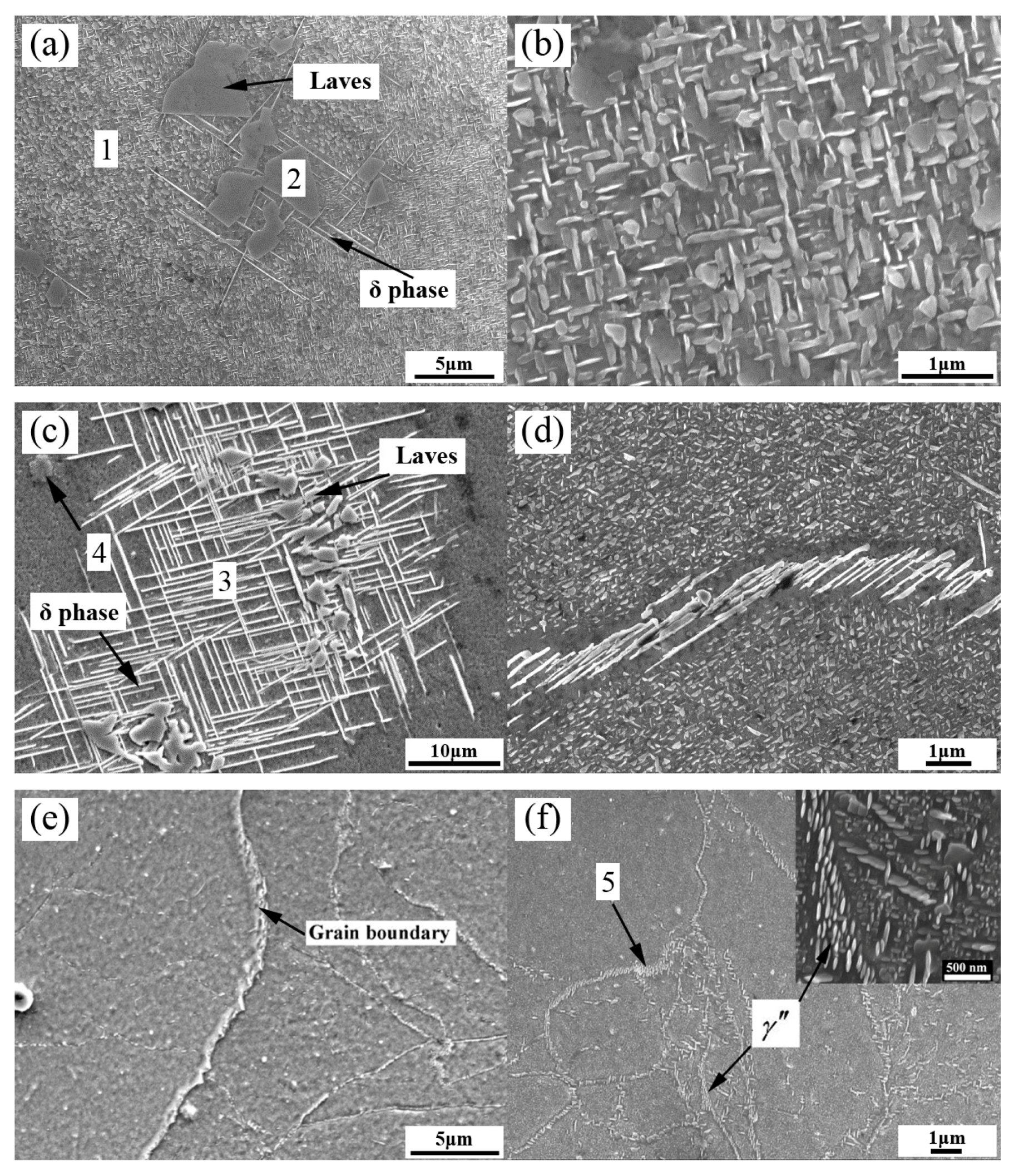
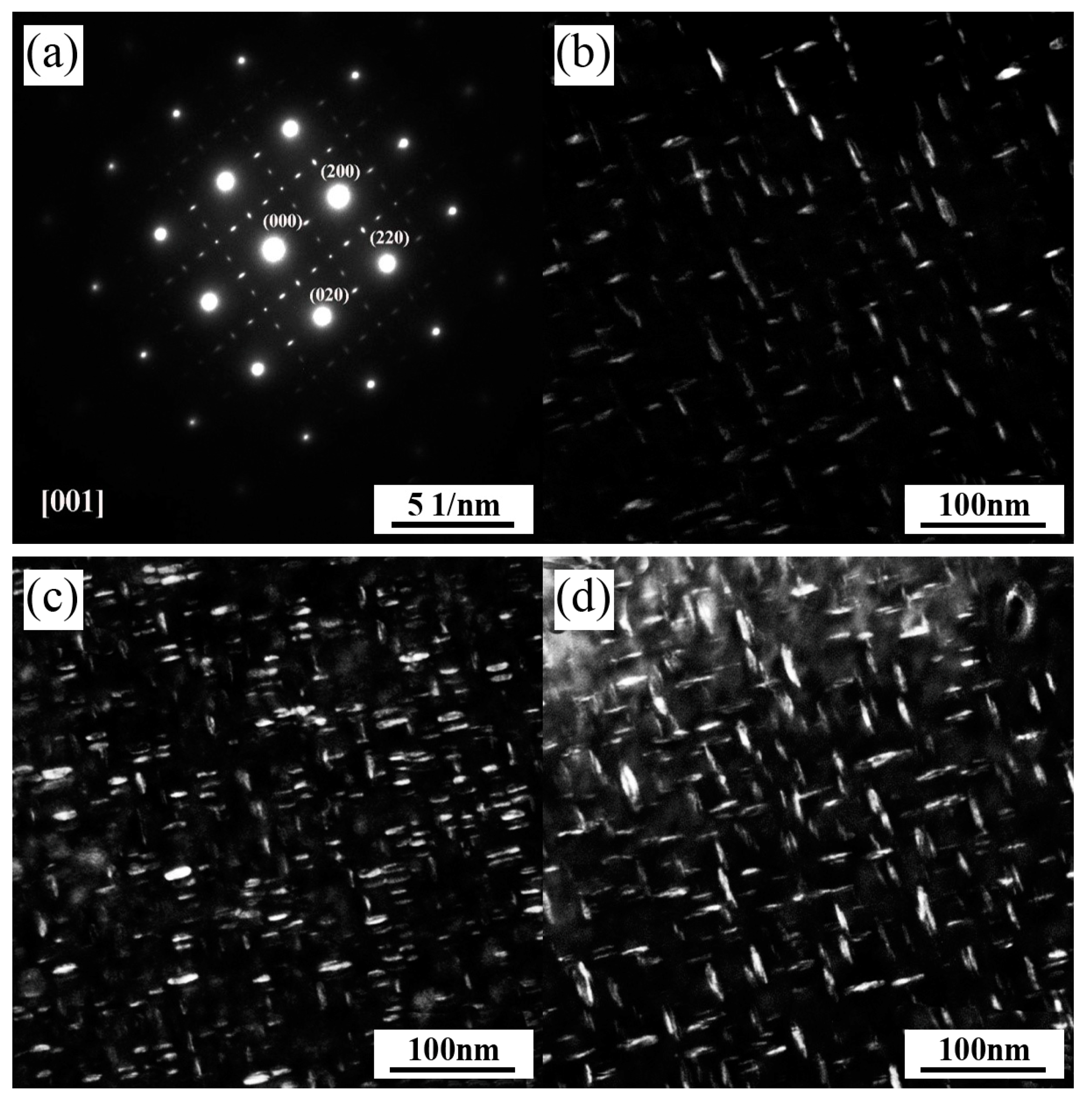
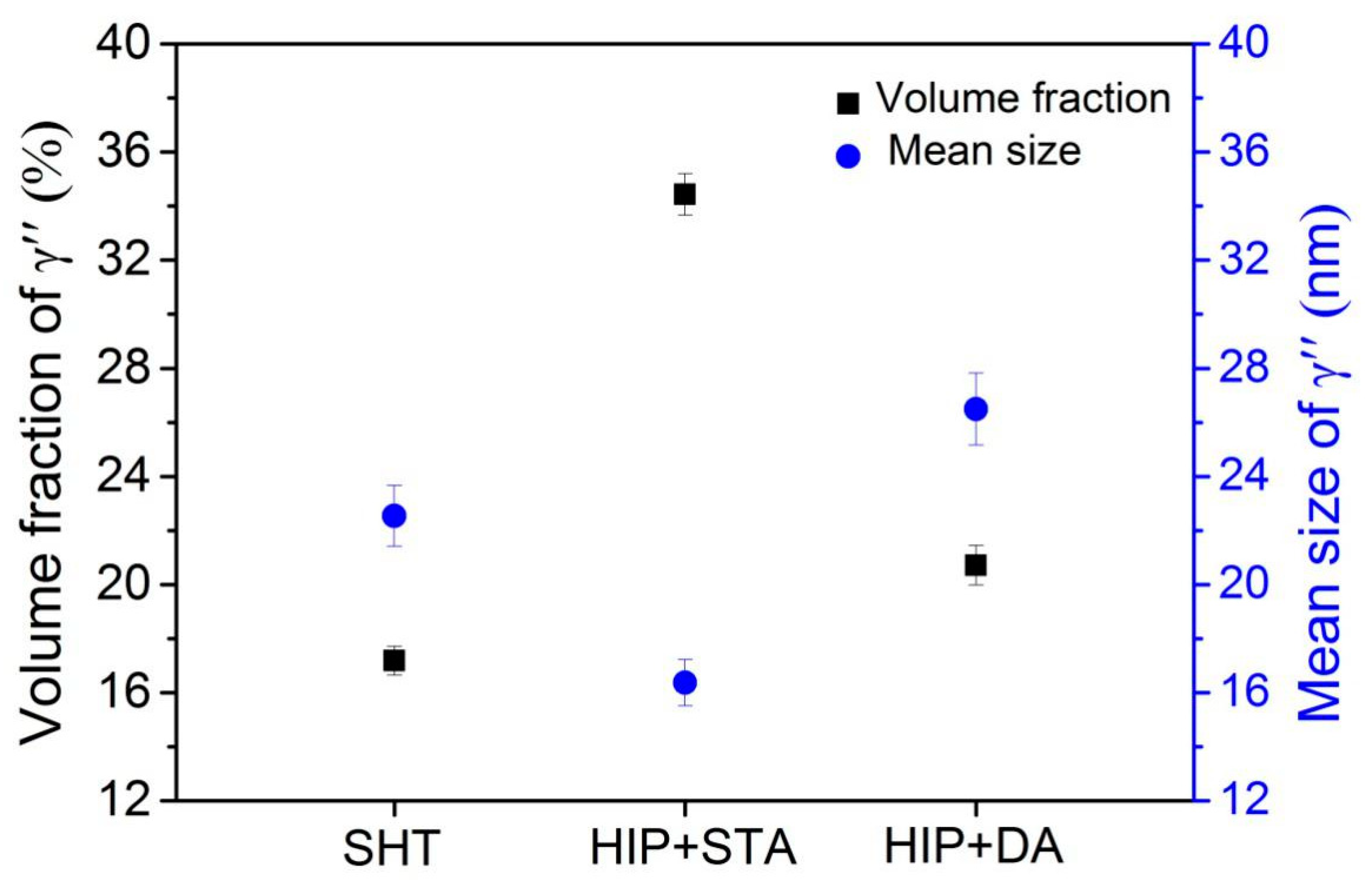
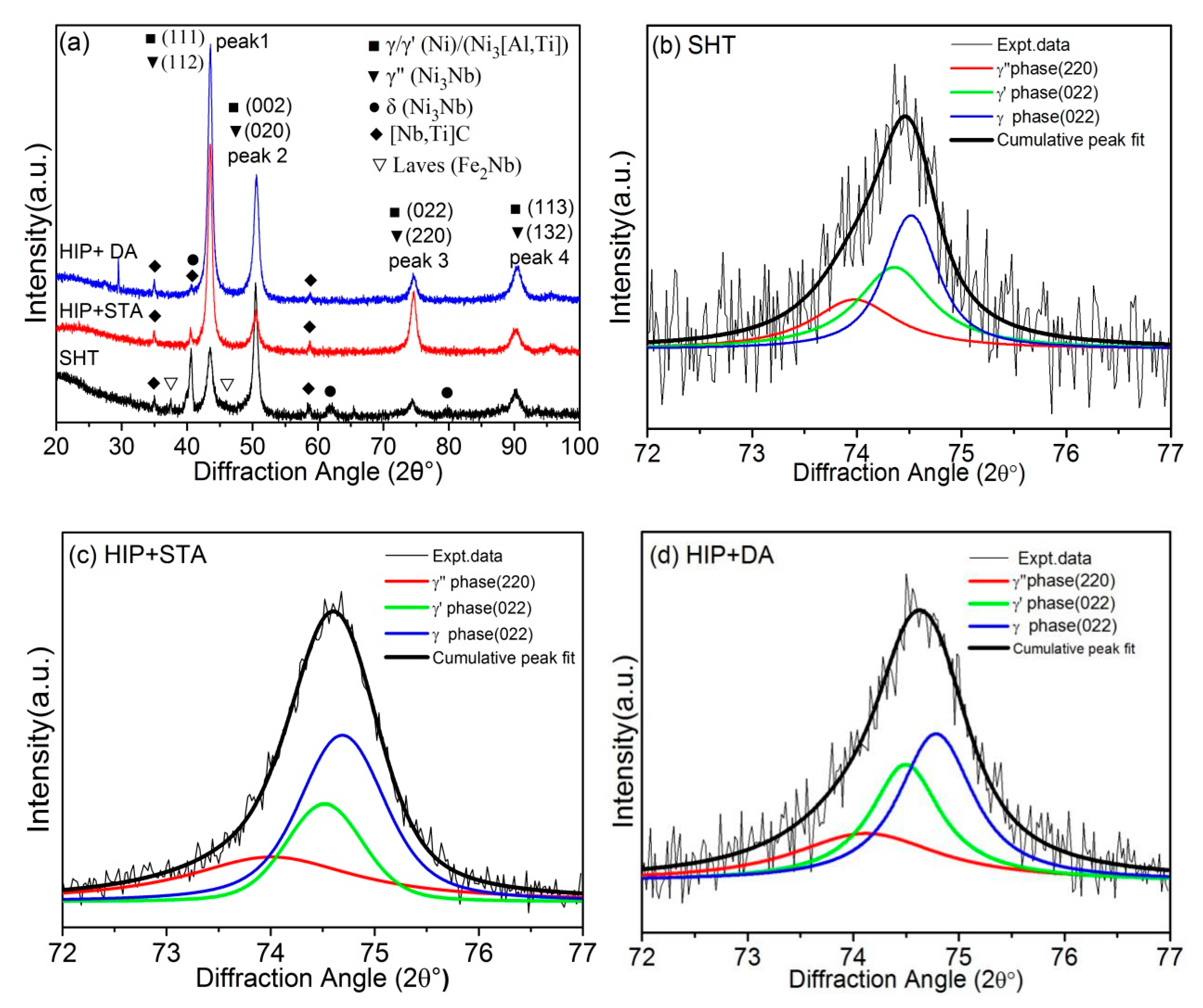
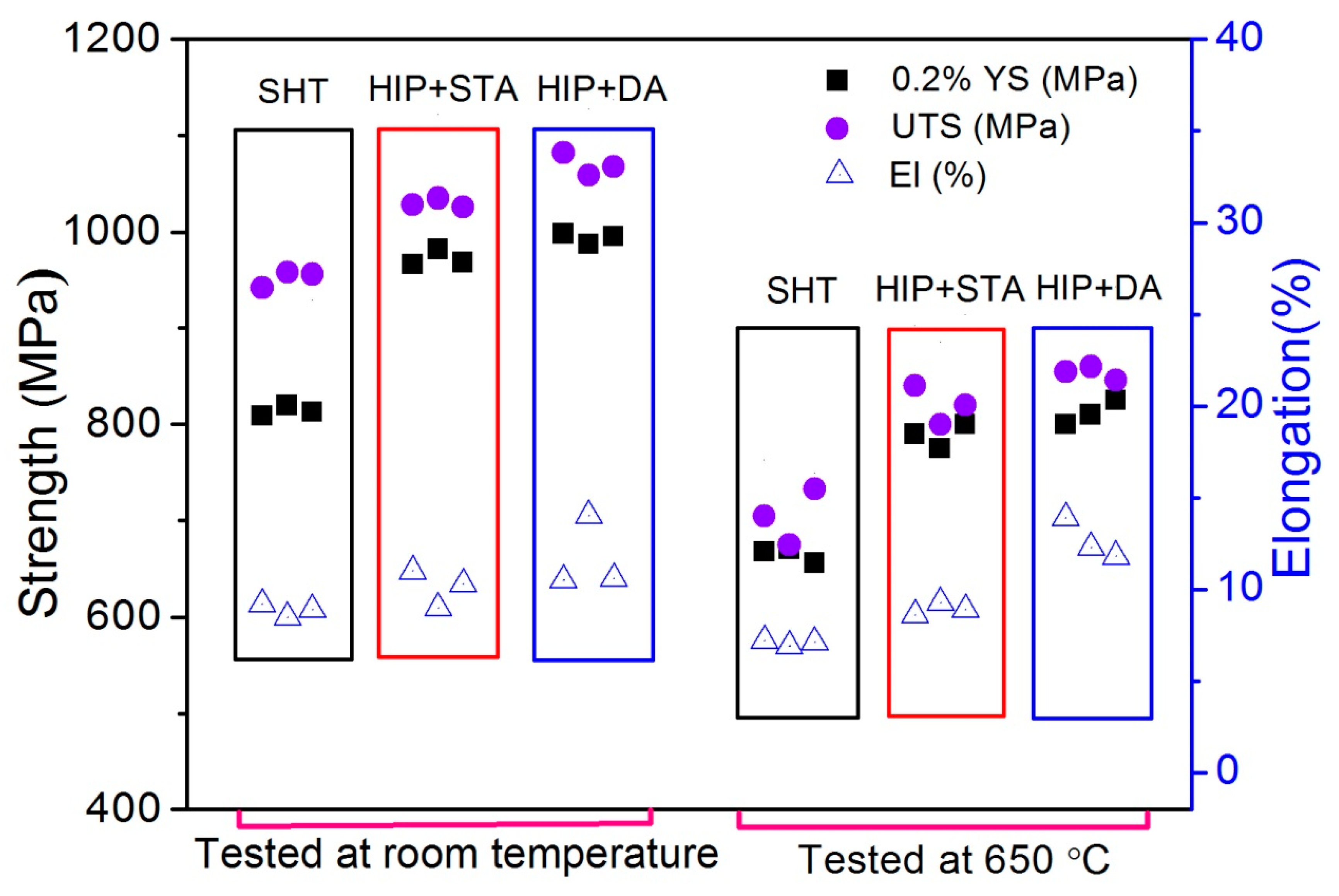
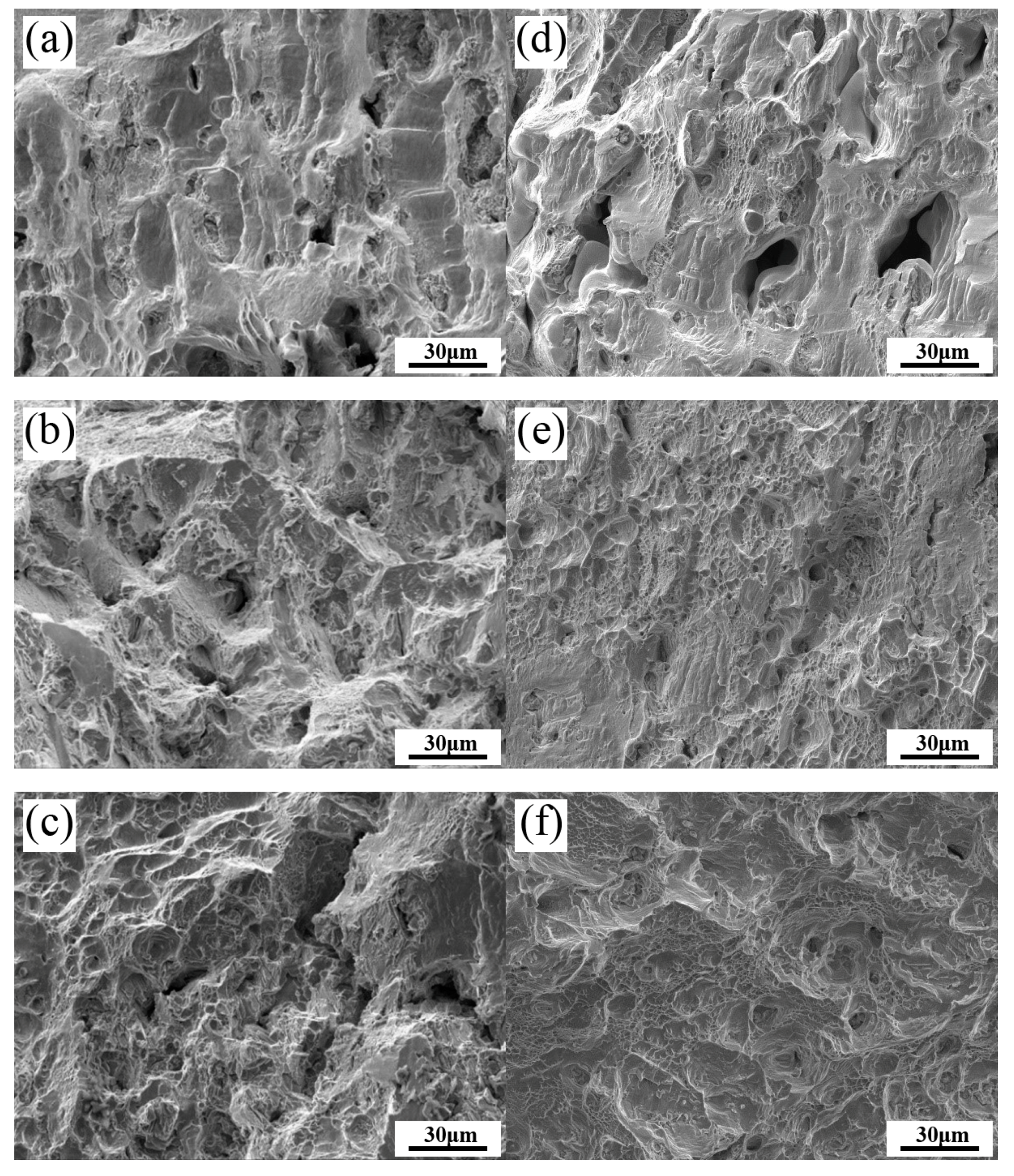

| Spot | Phase Designation | Ni | Fe | Cr | Nb | Ti | C | Mo | Al |
|---|---|---|---|---|---|---|---|---|---|
| 1 | Matrix | 52.48 | 18.99 | 19.68 | 2.47 | 0.86 | 2.61 | 2.46 | 0.35 |
| 2 | Laves | 37.39 | 11.25 | 12.11 | 29.71 | 1.07 | – | 8.09 | 0.35 |
| 3 | δ | 54.08 | 12.31 | 13.90 | 13.51 | 2.10 | – | 3.72 | 0.38 |
| 4 | MC-carbide | 2.61 | 1.12 | 0.88 | 66.81 | 7.51 | 13.69 | 7.31 | 0.38 |
| 5 | γ″ | 53.21 | 11.28 | 12.80 | 13.61 | 2.12 | – | 6.62 | 0.36 |
| Treatments | Lattice Parameter (nm) | Lattice Misfit ε (%) | |||
|---|---|---|---|---|---|
| γ Phase | γ′ Phase | γ″ Phase | γ/γ′ | γ/γ″ | |
| SHT | a = 0.3601 | a = 0.3607 | a = 0.3620 c = 0.7408 | 0.1847 | 0.5407 |
| HIP + STA | a = 0.3601 | a = 0.3608 | a = 0.3619 c = 0.7338 | 0.1869 | 0.4985 |
| HIP + DA | a = 0.3603 | a = 0.3610 | a = 0.3626 c = 0.7492 | 0.1928 | 0.6320 |
| Treatment | YS (MPa) | UTS (MPa) | EL (%) | YS(MPa) | UTS (MPa) | EL (%) |
|---|---|---|---|---|---|---|
| Room Temperature | 650 °C | |||||
| SHT | 814 ± 5.6 | 952 ± 8.7 | 8.9 ± 0.4 | 666 ± 7.7 | 703 ± 29.1 | 7.1 ± 0.2 |
| HIP + STA | 972 ± 8.7 | 1030 ± 4.7 | 10.1 ± 1.0 | 788 ± 12.6 | 820 ± 20 | 8.9 ± 0.4 |
| HIP + DA | 993 ± 5.7 | 1070 ± 11.6 | 11.7 ± 2.0 | 811 ± 12.6 | 854 ± 10.0 | 12.7 ± 1.1 |
| Wrought material | 1035–1067 | 1275–1400 | 12–21 | 860–1000 | 1000–1200 | 12–19 |
| Treatments | Strengthening Method | SHT | HIP + STA | HIP + DA |
|---|---|---|---|---|
| (MPa) | coherent strain strengthening | 232.83 | 337.04 | 316.43 |
| (MPa) | dislocation-cut ordered particle strengthening | – | – | 43.19 |
© 2019 by the authors. Licensee MDPI, Basel, Switzerland. This article is an open access article distributed under the terms and conditions of the Creative Commons Attribution (CC BY) license (http://creativecommons.org/licenses/by/4.0/).
Share and Cite
Ling, L.-S.-B.; Yin, Z.; Hu, Z.; Liang, J.-H.; Wang, Z.-Y.; Wang, J.; Sun, B.-D. Effects of the γ″-Ni3Nb Phase on Mechanical Properties of Inconel 718 Superalloys with Different Heat Treatments. Materials 2020, 13, 151. https://doi.org/10.3390/ma13010151
Ling L-S-B, Yin Z, Hu Z, Liang J-H, Wang Z-Y, Wang J, Sun B-D. Effects of the γ″-Ni3Nb Phase on Mechanical Properties of Inconel 718 Superalloys with Different Heat Treatments. Materials. 2020; 13(1):151. https://doi.org/10.3390/ma13010151
Chicago/Turabian StyleLing, Li-Shi-Bao, Zheng Yin, Zhi Hu, Jin-Hui Liang, Zhi-Yong Wang, Jun Wang, and Bao-De Sun. 2020. "Effects of the γ″-Ni3Nb Phase on Mechanical Properties of Inconel 718 Superalloys with Different Heat Treatments" Materials 13, no. 1: 151. https://doi.org/10.3390/ma13010151
APA StyleLing, L.-S.-B., Yin, Z., Hu, Z., Liang, J.-H., Wang, Z.-Y., Wang, J., & Sun, B.-D. (2020). Effects of the γ″-Ni3Nb Phase on Mechanical Properties of Inconel 718 Superalloys with Different Heat Treatments. Materials, 13(1), 151. https://doi.org/10.3390/ma13010151





